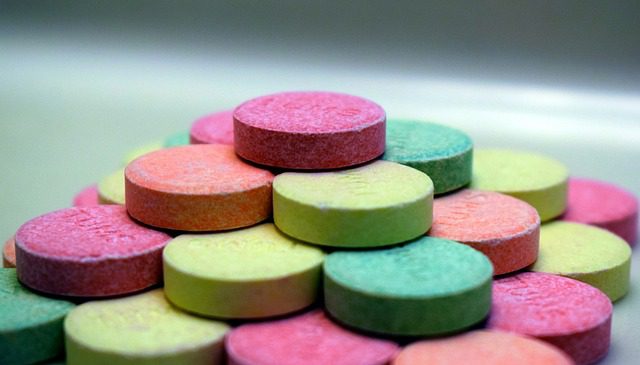Chemical Food Additives
Dr. Jimmy Steger
This alphabetical listing of the most common food additives includes what they’re used for, some of the foods in which they’re found, and our assessment of their safety.
Acesulfame Potassium. (Everyone should avoid) – Artificial sweetener: Chewing gum, diet soda, no-sugar added baked goods and desserts, tabletop sweetener (Sunett).
Poorly done safety tests in the 1970s suggested that acesulfame potassium may cause cancer. The Food and Drug Administration has refused to require better studies. Acesulfame Potassium is often used with sucralose.
Alginate, Propylene Glycol Alginate. (Cut Out) – Foam stabilizers, thickening agents: Beer, candy, cheese, ice cream, yogurt. They’re made from seaweed (kelp).
Alpha Tocopherol (Vitamin E). (Safe) – Antioxidant, nutrient: Oils. Small amounts are added to oils to keep them from going rancid and to other foods to pump up the vitamin E.
Artificial and Natural Flavoring. (Certain people should avoid.) – Breakfast cereal, candy, soda, many other foods. Most of the hundreds of chemicals used to mimic natural flavors also occur in nature are probably safe. But flavorings are often used in junk foods to mask the absence of natural ingredients (fruit, for example). Flavorings may include additives like MSG or HVP, to which some people are sensitive.
Ascorbic Acid (Vitamin C), Erythorbic Acid. (Safe) – Antioxidant, color stabilizer, nutrient: Cereal, cured meat, fruit drinks. It helps maintain the red color of ham, bacon, and other cured foods and it inhibits the formation of cancer-promoting nitrosamines (see Sodium Nitrate). Vitamin C is also used to pump up the vitamin content of foods like “fruit” drinks. Sodium ascorbate is a form of ascorbic acid that dissolves easily. Erythorbic acid is chemically similar to ascorbic acid, but it isn’t a vitamin.
Aspartame (NutraSweet). (Everyone should avoid) – Artificial sweetener: Frozen desserts, diet soda, tabletop sweetener (Equal). Disturbing new Italian research in animals indicate that long term consumption may increase the risk of leukemia, lymphoma, and breast cancer. Although some people report dizziness, hallucinations, or headaches after drinking diet soda, only one of the controlled studies that looked for a link found one (to headaches). People with the rare disease PKU (phenylketonuria) need to avoid aspartame.
Beta-Carotene. (Safe) – Coloring, nutrient: Coffee creamer, margarine, butter, candy. It’s an orange pigment that the body converts to vitamin A.
Brominated Vegetable Oil (BVO) (Caution) – Clouding agent, emulsifier: Soft drinks. It’s occasionally used to keep flavor oils in suspension and give a cloudy appearance to citrus-flavored soft drinks. Small residues of BVO remain in body fat, but it’s unclear whether they pose any risk.
Butylated Hydroxanisole (BHA) (Caution) – Antioxidant: Cereal packages, chewing gum, oil, potato chips. It retards rancidity in fats, oils, and foods that contain oil. According to the federal government’s National Toxicology Program, it is “reasonably anticipated to be a human carcinogen,” based on animal studies.
Caffeine (Cut Out) – Flavoring, stimulant: Added to soft drinks and water. Occurs naturally in coffee, tea, cocoa, and chocolate. It improves alertness and endurance, especially for the sleep-deprived but can also interfere with sound sleep and make you jittery. If you have these symptoms, consider cutting back. Caffeine is mildly addictive; it causes headaches, irritability, or sleepiness when you go too long without it. High doses (more than 200mg a day) may increase the risk of miscarriage or rare birth defects. Avoid caffeine if you are pregnant or are trying to become pregnant.
Calcium Propionate, Sodium Propionate. (Safe) – Preservative: Bread, cake, pies, rolls. Calcium propionate prevents the growth of mold on bread and rolls. The calcium is a nutrient and the propionate is safe. Since calcium interferes with leavening agents, sodium propionate, which is also safe, is used in pies and in cake.
Calcium (or Sodium) Stearoyl Lactylate or Sodium Stearoyl Fumarate. (Safe) – Dough conditioner, whipping agent: Artificial whipped cream, bread dough, cake filling, processed egg whites. They strengthen bread dough so it can be used in commercial bread-making machinery. They help produce a more uniform grain and greater bread volume. And they act as a whipping agent in dried, liquid, or frozen egg whites and artificial whipped cream.
Carrageenan. (Safe) – Stabilizing and thickening agent: Chocolate milk, Cottage cheese, ice cream, infant formula, jelly. It comes from seaweed. Large amount have damaged the colons of test animals, though the small amounts in foods are safe.
Casein, Sodium Caseinate. (Avoid) – Casein is the principal protein in milk. Since it’s used in some “non-dairy” and “vegetarian” foods, people who are allergic to milk need to read labels carefully. The is primary ingredient in most glues to make it sticky.
Citric Acid, Sodium Citrate. (Safe) – Citric acid is used as a tart flavoring and an antioxidant. Sodium citrate is a buffer that controls the acidity of gelatin desserts, jams, ice creams, candies, and other foods.
Cochineal or Carmine. (Certain people should avoid) – Cochineal extract is a red coloring made from the dried and pulverized bodies of insects. Carmine is a more purified coloring made from cochineal. Both have caused rare allergic reactions that range from hives to life-threatening anaphylactic shock.
Corn Syrup. (Cut Back) – Corn syrup – which consists mostly of dextrose—is a sweet, thin liquid made by treating cornstarch with acids or enzymes. It is sometimes dried and used as corn syrup solids in coffee creamers and other dry foods. It has no nutritional value other than calories, it promotes tooth decay, and it’s used mainly in foods with little nutritional value.
Dextrose (Glucose, Corn Syrup). (Cut Back) – When added to foods as a sweetener, it means empty calories and tooth decay.
EDTA. (Safe) – Modern food-manufacturing technology leaves trace amounts of metal in food (from metal rollers, blenders, and containers). EDTA (ethylenediamine tetracetic acid) chelates the metals—that is, it traps impurities that would otherwise make oils rancid and break down artificial colors.
Ferrous Gluconate. (Safe) – it’s used to generate a uniform jet-black color in olives and as a source of iron in foods.
Fructose. (Cut Back) – Pure fructose is used as a sweetener in a small number of foods. Modest amounts consumed on a regular basis may raise the risk of heart disease by increasing blood triglyceride levels. They may also contribute to obesity because fructose affects hormones that regulate weight and may not curb appetite as much as an equal amount of glucose or sucrose.
Fumaric Acid. (Safe) – It adds tartness and acidity. To help it dissolve faster in cold water, it’s often mixed with dioctyl sodium sulfosuccinate (DSS), an additive that appears to be safe.
Gelatin. (Safe) – it’s a protein obtained from animal hides and bones that has less nutritional value than other proteins.
Glycerin (Glycerol). (Safe) – It’s a natural component of fat molecules. The body uses it for calories or to make more-complex molecules.
Gums (Arabic, Furcelleran, Ghatti, Guar, Karaya, Locust Bean, Tragacanth, Xanthan). (Safe, Certain people should avoid) – Gums are derived from natural sources (bushes, trees, seaweed, bacteria). Through poorly tested, they’re probably safe. In rare instances, tragacanth has caused severe allergic reactions.
High-Fructose Corn Syrup (HFCS). (Cut Back) – This mixture of two sugars (it’s about half fructose, half glucose) has largely replaced table sugar (sucrose) in soft drinks and many other foods because it’s cheaper. Despite the urban myth, it’s not worse for you than sucrose. Like other sugars, it promotes obesity, tooth decay, and–in people with high triglycerides—heart disease.
Hydrolyzed Vegetable Protein (HVP). (Certain people should avoid) – it consist of plant protein (usually from soybeans) that has been chemically broken down into it’s amino acid components. HVP brings out the natural flavor of food. It contains MSG. And large amounts may cause reactions in sensitive people (see MSG).
Inulin. (Safe) – It’s a naturally occurring soluble fiber. Inulin doesn’t raise blood sugar levels, so it may help people diabetes. It also stimulates the growth of friendly bacteria in the large intestine.
Invert Sugar. (Cut Back) – This 50-50 mixture of two sugars (dextrose and fructose) is sweeter and dissolves better than sucrose (table sugar). It’s nothing but empty calories and it contributes to tooth decay.
Lactic Acid. (Safe) – It inhibits spoilage in Spanish olives, balances the acidity in cheese, and adds tartness to frozen desserts, carbonated fruit-flavored sodas, and other foods.
Lactose. (Certain people should avoid) – Lactose (milk sugar) is nature’s way of delivering calories to infant mammals. It’s one-sixth as sweet as table sugar and is added to foods as a slightly sweet source of carbohydrates. Some adults have trouble digesting large amounts of lactose.
Lecithin. (Safe) – it occurs naturally in soybean oil and eggs. It keeps oil and water from separating, retards rancidity, reduces spattering, and helps make cake fluffier.
Maltitol, Mannitol. (Cut back) – Like other sugar alcohols (sorbitol, xylitol), maltitol and mannitol are not well absorbed by the body, so they have fewer calories than table sugar. And they don’t promote tooth decay. Large amounts (above 20 to 30grams) may have a laxative effect.
Maltodextrin. (Safe) – It’s made from starch. Some maltodextrins are easily digested and absorbed, while others are chemically processed so that they are “resistant”–they can’t be broken down by digestive enzymes. That makes them an isolated fiber. These resistant maltodextrins may help lower blood sugar levels, but don’t prevent constipation.
Mono- and Diglycerides. (Safe) – they make bread softer, margarine more stable, and caramel less sticky. They also prevent the oil in peanut butter from separating.
MSG (Monosodium Glutamate). (Avoid) – MSG is the sodium salt of a common amino acid, glutamic acid. It brings out the flavor of foods. In the 1960s, researchers discovered that large amounts fed to infant mice destroyed brain cells. Careful studies have shown that a small number of people are sensitive to large doses of MSG. Reactions include headache, nausea, weakness, and burning sensations in the back of the neck and the forearms. Other ingredients, like natural flavoring and hydrolyzed vegetable protein (HVP), also contain glutamate.
Mycoprotein. (Avoid) – it’s made from processed mold (fungus) and is fashioned into imitation meat. A small percentage of people are sensitive to it. Reactions include vomiting, nausea, diarrhea, and, less often, hives and potentially fatal anaphylactic reactions. The FDA has refused to ban the use of mycoprotein or to require foods to bear a warning label about adverse reactions.
Neotame. (Avoid) – Artificial sweetener: Diet soda, other diet food. It’s chemically related to aspartame, but is used at much lower levels. It’s also more stable (unlike aspartame, it can be used in baked foods). Neotame does not appear to be a problem for people with PKU (phenylketonuria).
Oat fiber, wheat fiber. (Safe) Isolated fiber: Cereal, crackers, bread, and muffins. When a food ingredient contains the word “fiber,” it’s code for an isolated fiber. “Wheat fiber” and “oat hull fiber” are insoluble fibers, which may help prevent constipation but don’t lower blood cholesterol or blood sugar. “Oat fiber” can either be soluble or insoluble fiber. Soluble fiber may lower blood cholesterol and blood sugar but doesn’t prevent constipation.
Olestra (Olean). (Everyone should avoid) – fat substitute: Lay’s light chips, Pringles light chips. It’s a synthetic fat that isn’t absorbed as it passes through the digestive system, so it has no calories. It can cause severe and incapacitating diarrhea, loose stools, abdominal cramps, and flatulence.
Oligofructose. (Safe) – Sweetener, bulking agent, and emulsifier, prebiotic: Frozen desserts, cookies, energy and granola bars. It’s either synthesized from sucrose or extracted from chicory root. Like insulin and other soluble fibers, oligofructose is digested by bacteria in the large intestine, but not by human enzymes, and provides only about half the calories of fructose or other sugars. Oligofructose promotes the growth of beneficial bifidus bacteria.
Partially Hydrogenated Oil. (Everyone should avoid) – Fat: Baked goods, fried restaurant foods, icing, microwave popcorn, piecrust, shortening, stick margarine. Vegetable oil can be made into a semisolid shortening or margarine by chemically adding hydrogen. The process creates transfats, which raise LDL (“bad”) cholesterol and lower HDL (“good”) cholesterol, making them worse for you heart than saturated fat.
Phosphates, Phosphoric Acid. (Safe) – Acidulant, buffer, cleaning agent, color stabilizer, emulsifier, nutrient: Baked goods, breakfast cereal, cheese, cured meat, dehydrated potatoes, powdered food, soda. While excessive consumption of phosphates may contribute to osteoporosis, only a small fraction of the phosphates in the diet comes from additives.
Phytosterols or Phytostanols. (Safe) – Cholesterol-lowerers: Margarine (Benecol, take control), added to some orange juices and breads. Plant sterols (or stanols) are found naturally in many nuts, seeds vegetable oils, fruits, vegetables, and other foods. High doses can reduce the absorption of cholesterol from food, which can lower LDL (bad) cholesterol levels by 10 to 15 percent. They may also slightly reduce the absorption of carotenoids.
Polydextrose. (Cut Back) – Bulking agent: Reduced-calorie salad dressing, baked goods, candies, pudding, frozen desserts. Polydextrose is made by combining dextrose (corn sugar) with the sugar alcohol sorbitol. The result is a slightly sweet, reduced calorie-bulking agent. The FDA requires labels of foods that would likely provide more than 15 grams of polydextrose to carry a mild warning: “Sensitive individuals may experience a laxative effect from excessive consumption of this product.”
Polysorbate 60. (Safe) – Emulsifier: Baked goods, frozen desserts, imitation cream. Polysorbate 60 and its close relatives, polysorbate 65 and polysorbate 80, work like mono- and diglycerides. They keep baked goods from going stale, keep dill oil(a flavoring) dissolved in bottles dill pickles, help coffee creamers dissolve, and prevent oil from separating in artificial whipped cream.
Potassium Bromate. (Everyone should avoid) – Dough strengthener: white flower. Most bromate rapidly breaks down to form innocuous bromides. However, bromate itself causes cancer in animals, and the tiny amounts that may remain in bread pose a small risk. Bromate was banned in the United Kingdom in 1989 and it isn’t used in California (probably because foods made with it would have to carry a cancer warning).
Propyl Gallate. (Everyone should avoid) – Antioxidant, preservative: Chewing gum, chicken soup base, meat potato sticks, oil. It helps prevent fats and oils from spoiling and is often used together with BHA and BHT. The best animal studies hinted that it might cause cancer.
Quinine. (Caution)(Certain people should avoid) – Flavoring: Bitter lemon, Quinine water, tonic water. Quinine has been poorly tested as a food additive, and there’s a slight chance that it causes birth defects, so pregnant women should avoid it.
Saccharin. (Everyone should avoid) – Artificial sweetener: No-sugar added foods, tabletop sweetener (Sweet’N Low). Animal studies have shown that it can cause cancer of the bladder, uterus, ovaries, skin, and other organs. It also appears to increase the potency of other cancer-causing chemicals. A National Cancer Institute study found that heavy-saccharin users had higher rates of bladder cancer than people who used smaller amounts.
Salt (Sodium Chloride). (Avoid) – Flavoring, preservative: Most processed foods. It’s probably the single most harmful substance in the food supply. In most people, a diet high in sodium increases blood pressure, which raises heart disease risk.
Sodium Benzoate, Benzoic Acid. (Certain people should avoid) – It appears to be safe, though sensitive people may experience hives, asthma, or other allergic reactions. Sodium benzoate may also exacerbate hyperactivity in some children. When sodium benzoate is used in acidic beverages that also contain ascorbic acid (vitamin C), the two can form small amounts of benzene, which causes leukemia and other cancers. Under threat of a lawsuit, the leading soft-drink makers recently re-formulated their beverages—typically fruit-flavored drinks—to prevent the reaction.
Sodium Carboxymethylcellulose (CMC). (Safe) – Among other things, it keeps sugar from crystallizing.
Sodium Nitrate, Sodium Nitrite. (Everyone should avoid) – Sodium nitrite stabilizes the red color in cured meat and adds flavor. Without it, hot dogs and bacon would look gray. It also helps prevent the growth of bacteria that cause botulism. Adding nitrite to food can create small amounts of potent cancer causing chemicals called nitrosamines, particularly in fried bacon. Companies now add ascorbic acid or erthorbic acid to bacon to keep nitrosamines from forming. While nitrate and nitrite introduce only a small cancer risk, they’re still worth avoiding.
Sorbic Acid, Potassium Sorbate. (Safe) – Sorbic acid occurs naturally in many plants.
Sorbitan Monostearate (Safe) – like mono- and diglycerides and polysorbates, it keeps oil and water from separating. In chocolate candy, it prevents the discoloration that normally occurs when the candy is warmed up and then cooled.
Sorbitol. (Cut Back) – it’s a sugar alcohol that occurs naturally in fruits and is a close relative of sugar, though it’s half as sweet. Because bacteria don’t metabolize sorbitol well, it’s used in no-sugar-added chewing gum, which doesn’t cause tooth decay. Some diabetics use sorbitol-sweetened foods because it’s absorbed slowly and doesn’t cause blood sugar to increase rapidly. Moderate amounts of sorbitol may have strong laxative effect, but otherwise it’s safe.
Starch, Modified Starch. (Safe) – It’s used in many foods as a thickening agent and to keep solids suspended. Chemists can “modify” it with certain chemicals to make it dissolve in cold water. Starch and modified starches sometimes replace nutritious ingredients like fruit. One preliminary study indicated that modified starches can cause diarrhea in infants.
Stevia. (Safe) – Small amounts are safe. High doses of fed to rats reduced sperm production and increased cell proliferation in their testicles, which could cause infertility or other problems. Stevia can only be sold in the United States as a dietary supplement, but several companies are reportedly developing a stevia-derived sweetener and plan to seek approval from the FDA to use it in foods.
Sucralose. (Avoid) – unlike aspartame, sucralose can be used in baked foods. It appears to be the safest artificial sweetener, however I do not recommend this to anyone.
Sugar (Sucrose). (Avoid) – Sucrose (table sugar) occurs naturally in fruit, sugar cane, and sugar beets. Sugar, corn syrup, and other refined sweeteners make up about 15 percent of the average person’s diet, but provide no vitamin, minerals, fiber, or protein. Sugar molecules feed cancer and also shrinks the thymus gland. Not good!
Sulfites (Sodium Bisulfite, Sulfur Dioxide). (Certain people should avoid) – Sulfiting agents prevent discoloration (in dried fruit, some fresh shrimp, and some dried, fried, or frozen potatoes) and bacterial growth (in wine). They also destroy vitamin B-1. Sulfites can cause severe reactions in sensitive people, especially those with asthma.
Thiamin Mononitrate. (Safe) – It’s perfectly safe.
Vanillin, Ethyl Vanillin. (Safe) – Vanilla flavoring is derived from a bean, but vanillin, the major flavor component of vanilla, s cheaper to produce in a factory. A derivative, ethyl vanillin, comes closer to matching the taste of real vanilla.
Xylitol. (Cut Back) – like other sugar alcohols (maltitol, mannitol, sorbitol), xylitol is not well absorbed by the body, so it has fewer calories than table sugar. And it doesn’t promote tooth decay. Large amounts may have a laxative effect.
Quick Reference Shopping Guide
Safe
Alginate
Alpha tocopherol (Vitamin E)
Ascorbic Acid (Vitamin C)
Beta-Carotene
Calcium propionate
Calcium stearoyl lactylate
Carrageenan
Citric Acid
Eliminate
Corn syrup
Dextrose (corn sugar, glucose)
High-fructose corn syrup (HFCS)
Invert sugar
Maltitol
Mannitol
Polydextrose
Salt (sodium chloride)
Dioctyl sodium sulfosuccinate
EDTA
Ethyl vanillin
Ferrous gluconate
Fumaric acid
Fructose
Gelatin
Glycerin (glycerol)
Gums (Arabic, furcelleran, ghatti, guar, karaya, locust bean, xanthan)
Inulin
Lactic acid
Lecithin
Maltodextrin
Modified starch
Mono- and diglycerides
Neotame
Oat fiber
Oligofructose
Phosphates
Phosphoric acid
Phytostanols
Phytosterols
Polysorbate 60, 65, 80
Potassium sorbate
Sodium ascorbate
Sodium carboxymethyl-cellulose
Sodium citrate
Sodium propionate
Sodium stearoyl fumarate
Sodium stearoyl lactylate
Sorbic acid
Sorbitan monostearate
Sorbitol
Starch
Stevia
Thiamin mononitrate
Vanillin
Wheat fiber
Xylitol
Until next time, stay healthy!
Dr. Jimmy Steger
Artificial colorings (Citrus Red 2, Red 40)
Brominated vegetable oil (BVO)
Butylated hydroxytoluene (BHT)
Quinine
Artificial colorings (Yellow 5)
Artificial and natural flavoring
Caffeine
Casein
Cochineal
Gums (tragacanth)
Hydrolyzed vegetable protein (HVP)
Lactose
MSG (monosodium glutamate)
Mycoprotein (Quorn)
Quinine
Sodium benzoate
Sodium caseinate
Sulfites (sodium bisulfite, sulfur dioxide)
Proplene glycol alginate
Acesulfame potassium
Artificial colorings (Blue 1, Blue 2, Green 3, Red 3, Yellow 6)
Aspartame (NutraSweet)
Butylated hydroxyanisole (BHA)
Olestra (Olean)
Partially hydrogenated oil
Potassium bromate
Propyl gallate
Saccharin
Sodium nitrate, sodium nitrite
Sucralose
Sugar










